IFFO’s Technical Director Brett Glencross opened the Challenges and Opportunies session held at IFFO's Annual conference on 25 October with a quick recap of IFFO’s technical and regulatory work. Most notably he covered IFFO’s work with the Global Feed Life Cycle Assessment Institute (GFLI) to update global data on marine ingredients. The GFLI has been established to be an independent repository with a freely available database and the marine ingredients data set is currently limited and based on relatively outdated production practices.
LCA: Comparing apples with apples
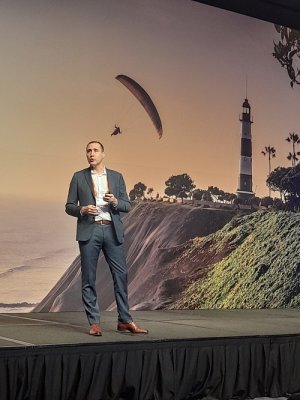
Starting with feed, Skretting’s Global Sustainability Manager Jorge Diaz Salinas presented their latest insights on formulating aquaculture feeds with a life cycle mindset. He noted that aquaculture is the solution to address the triple challenge of population growth, climate change and social impacts. With an expected growth rate of 22% by 2030, more ingredients are needed. While feed also plays a key role in reducing aquaculture’s greenhouse gas (GHG) emissions, with 94% of Skretting’s total GHG emission coming from ingredients. Skretting is working with suppliers using Science Based Targets (SBT), towards 2030 reduction commitments. A key aspect of the strategy is understanding which species and feed are suited to specific regions in the world. Marine Ingredients have a lower carbon footprint compared to other vegetable alternatives, but increasing their use only to reduce the carbon footprint of the feed could negatively impact fisheries.
Taking a holistic approach, Diaz noted that the industry needs to focus on the complete life cycle rather than single stages, looking at both the environmental and social footprints of their activities. The main challenges in doing this includes ensuring that we are comparing ‘apples with apples’ and that we know where our ingredients are coming from, increasing the use of primary data rather than secondary data, considering environmental impacts at Scope1, 2 and 3, and dealing with price volatility. Skretting is following the Product Environmental Footprint Category Rules (PEFCR) to ensure consistency of data use, covering all their materials, using an economic allocation approach, and ensuring land use change is considered. But more primary data is needed to improve the accuracy of the data and to allow clearer tracking of potential reductions. Carbon footprint cannot be looked at in isolation, it needs to be viewed in line with many other sustainability indicators, many of which are picked up by the LCA approach. In summary, Skretting’s approach is to push towards development of feed with the lowest environmental impact, social impact, and cost. “There can be no sustainability without profitability” said Diaz, noting that sustainability is far more than carbon footprint.
Raising the bar: We need to commit and start using, ESG – feed methodology
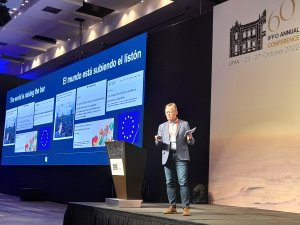 Moving further along the value chain, Tor Eirik Homme, the Director Feed and Nutrition at Grieg Seafood, presented the future of feed from a fish farmers perspective. Homme noted that his company is facing the same questions from customers, NGOs and investors, where are the feed ingredients coming from and do you know your supply chain. There are clear challenges now facing the aquaculture industry, from ensuring biodiversity, improving fish health and welfare, circularity of resources, ensuring sustainable feed use, and reducing GHGs.
Moving further along the value chain, Tor Eirik Homme, the Director Feed and Nutrition at Grieg Seafood, presented the future of feed from a fish farmers perspective. Homme noted that his company is facing the same questions from customers, NGOs and investors, where are the feed ingredients coming from and do you know your supply chain. There are clear challenges now facing the aquaculture industry, from ensuring biodiversity, improving fish health and welfare, circularity of resources, ensuring sustainable feed use, and reducing GHGs.
For fish feed, Homme stated that reducing carbon emissions is a key priority across the feed supply chain, setting science-based targets in line with the Paris agreement, including both your company’s operations and your supply chain. Annual reporting is key to ensuring transparency and traceability, there is not enough of either at the moment. Again, accuracy on the primary data is vital to track reductions clearly. Building an ESG model (Environmental – Social and Governance) ensures a risk assessment and company to company approach. Collaboration was again called for to develop a common methodology to assess ESG topics. Regarding alternative feed resources, salmon farming started with fishmeal and fish oil and it is still part of our feed, it is needed, but alternatives are also needed, but they will not outcompete fishmeal and fish oil in terms of nutrition.
There is a future for fishmeal and fish oil as long as it is based on sustainable sources (with a common ESG perspective) and is price competitive. Further improvement is needed in certification, transparency and traceability, labour rights on fishing vessels, and avoiding competition with human food.
Changing the debate on feed
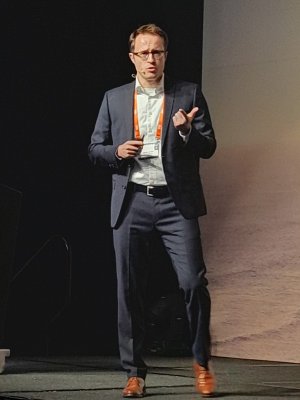 ASC’s Director of Standards and Science Michiel Fransen called on the marine ingredient industry to be a leader by 2040. Marine ingredients can be leading in taking ownership, ensuring sustainable supply and setting a global example of how to manage resources for generations to come. Progress has been made, such as with transparency and certification, but more work is needed on transparency and improvements in supply. Transparency underpins the trust of customers, and the trust that their customers have in the product.
ASC’s Director of Standards and Science Michiel Fransen called on the marine ingredient industry to be a leader by 2040. Marine ingredients can be leading in taking ownership, ensuring sustainable supply and setting a global example of how to manage resources for generations to come. Progress has been made, such as with transparency and certification, but more work is needed on transparency and improvements in supply. Transparency underpins the trust of customers, and the trust that their customers have in the product.
Taking a risk management approach, Fransen identified two drivers: supply (stock management and by-products), and the reputation of the industry, especially in comparison to other commodities or alternatives. For stocks, climate change is changing fisheries and dependency on the oceans will only increase, so but the industry can capitalize on the head-start by looking at lessons already learned in fisheries management. Optimising by-product use is also providing opportunities in volumes, but the supplying fishery needs to be sustainably managed.
As an industry, marine ingredients need to message the right audience, taking a B2C approach rather than B2B. ASC is connecting with consumers with the aim to change the public debate, challenging the current discussion on concerns over fisheries and highlighting the balance of alternatives that require land use. If this is it not addressed, industry at the other end of the value chain, who are consumer facing, can either work with marine ingredients or exclude them. The industry has an opportunity to engage the end consumer more.
The public debate needs to be changed by levelling the playing field, addressing all ingredients with equal attention, including all plant ingredients. “Marine ingredients are ahead of the game” he insisted: traceability is just starting and is the answer.
Optimising human nutrition within global constraints
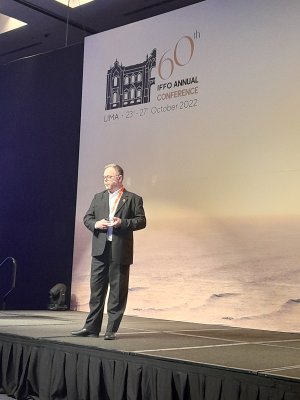 Exploring the role of marine ingredients in nutrition and global food systems, IFFO’s Technical Director, Dr Brett Glencross, opened by stating that a secure future relies on both nutritious and sustainable foods. Referring to a recent paper on climate impacts, small pelagic species are identified as top performers in both dimensions for low climate impacts and providing high nutrition, marine ingredients are a superfood generated in a sustainable way. This low carbon footprint is due to the low impact fishing methods used and the utilization of by-products. For nutrition, small pelagics are one of natures best nutrient sources, supporting immune function, growth, brain development and much more along with a high digestibility.
Exploring the role of marine ingredients in nutrition and global food systems, IFFO’s Technical Director, Dr Brett Glencross, opened by stating that a secure future relies on both nutritious and sustainable foods. Referring to a recent paper on climate impacts, small pelagic species are identified as top performers in both dimensions for low climate impacts and providing high nutrition, marine ingredients are a superfood generated in a sustainable way. This low carbon footprint is due to the low impact fishing methods used and the utilization of by-products. For nutrition, small pelagics are one of natures best nutrient sources, supporting immune function, growth, brain development and much more along with a high digestibility.
Used as a strategic resource, marine ingredients contribute to providing sustainable nutrients into our food chain, with 1kg of marine ingredient raw material producing 5kg of farmed fish. Over time there has been a marked shift in how these resources are used, from pigs and poultry to aquaculture, which is the most efficient use of this resource making sure we maintain to most direct access to these nutrients other than if we ate them directly ourselves. The specific features of small pelagics make them a unique resource, including their short life span, finite resource base, seasonal harvesting, and exceptional nutritional properties. Ideally we would eat such resources fresh, but those features of the sector (high seasonal volumes and high perishability) make this approach difficult. Increasingly alternative options like freezing and canning are being used to allow direct entry of those resources into the food chain, bit this still cannot take much of the volume. Stabilizing the resource by dehydration allows the best option for enabling the use of this resource and by directing it to sectors like aquaculture it ensures the next best option of supply of those marine nutrients to the global human diet.
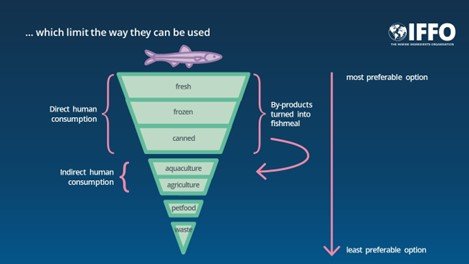
Used strategically in feed, fishmeal and fish oil accentuate the palatability of feed, influencing how much the fish eats, which is the first and most important hurdle for feed. Many of the unique nutritional benefits provided by fishmeal and fish oil are shown in the image below.
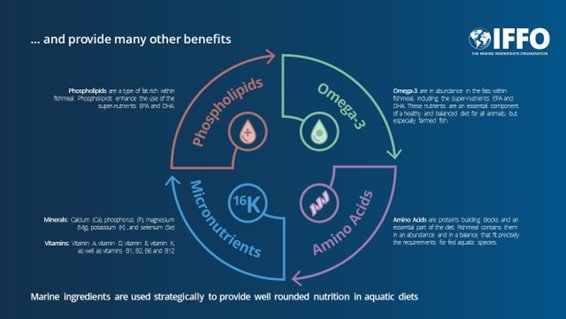
Delving into the role played by Omega-3’s, Glencross noted that they are not all equal, with long-chain omega-3s EPA and DHA working together to support growth, neurological health, eyes (retina), nervous system, cardiovascular system, and maintain normal blood triglyceride levels. Short chain omega-3s (ALA), are from plant sources and do not provide the same health benefits, while also not being converted or inefficiently converted into EPA and DHA. Fish oils contained in fatty fish are the most cost effective way to get essential EPA and DHA. Notably all animals need EPA and DHA in their diets, including humans, and fish oil remains the most effective way to get this into our diet. However human diets have become unbalanced over the last 100 years with typical diets now disproportionality higher in the inflammatory causing omega-6 instead.
Glencross concluded by noting the many benefits for humans, both direct and indirect, from fishmeal and fish oil. As a final conclusion, Glencross quoted the FAO’s latest SOFIA 2022 report, “Fishmeal and fish oil are still considered the most nutritious and most digestible ingredients for farmed fish, as well as the major source of omega-3 fatty acids.”
Panel Introductions and Discussion: Making the most of byproducts
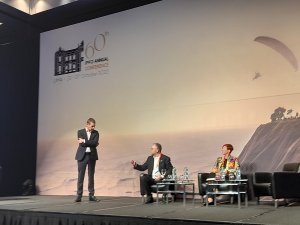 Glencross was joined by panelists Vincent Percier from Symrise Aqua Feed and Dr Silke Middendorf from Biomega Group. Discussion opened up on the use of palatability enhancers growing over recent years. Percier noted that reasons behind this growth differed between industries. In aquafeed, palatability enhancers are being used more now because of the trend towards lower fishmeal diets as a means to encourage improvements in feed intake, especially at times of change, such as with smolt transfer. In petfood, the palatability story is a little different and has to do with pleasure, it is also a sector where the value is much greater.
Glencross was joined by panelists Vincent Percier from Symrise Aqua Feed and Dr Silke Middendorf from Biomega Group. Discussion opened up on the use of palatability enhancers growing over recent years. Percier noted that reasons behind this growth differed between industries. In aquafeed, palatability enhancers are being used more now because of the trend towards lower fishmeal diets as a means to encourage improvements in feed intake, especially at times of change, such as with smolt transfer. In petfood, the palatability story is a little different and has to do with pleasure, it is also a sector where the value is much greater.
When exploring their companies focus on by-products, Percier noted that in aquafeed, cost is crucial and by-products cost less and have the added value of a zero FIFO ratio. He added that their focus on the by-product resource base was on species and not on if they are farmed or caught. Middendorf explained that Biomega focuses on salmon as they believe it is “best in class” in terms of its nutritional composition, with very high levels of various nutrients, like vitamin B12 for humans, and taurine levels for petfood. There is also great opportunity for diversification within the products, extracting products such as collagen (type 1) and gelatin, which have different properties than similar products from the traditional beef and pork sources.








